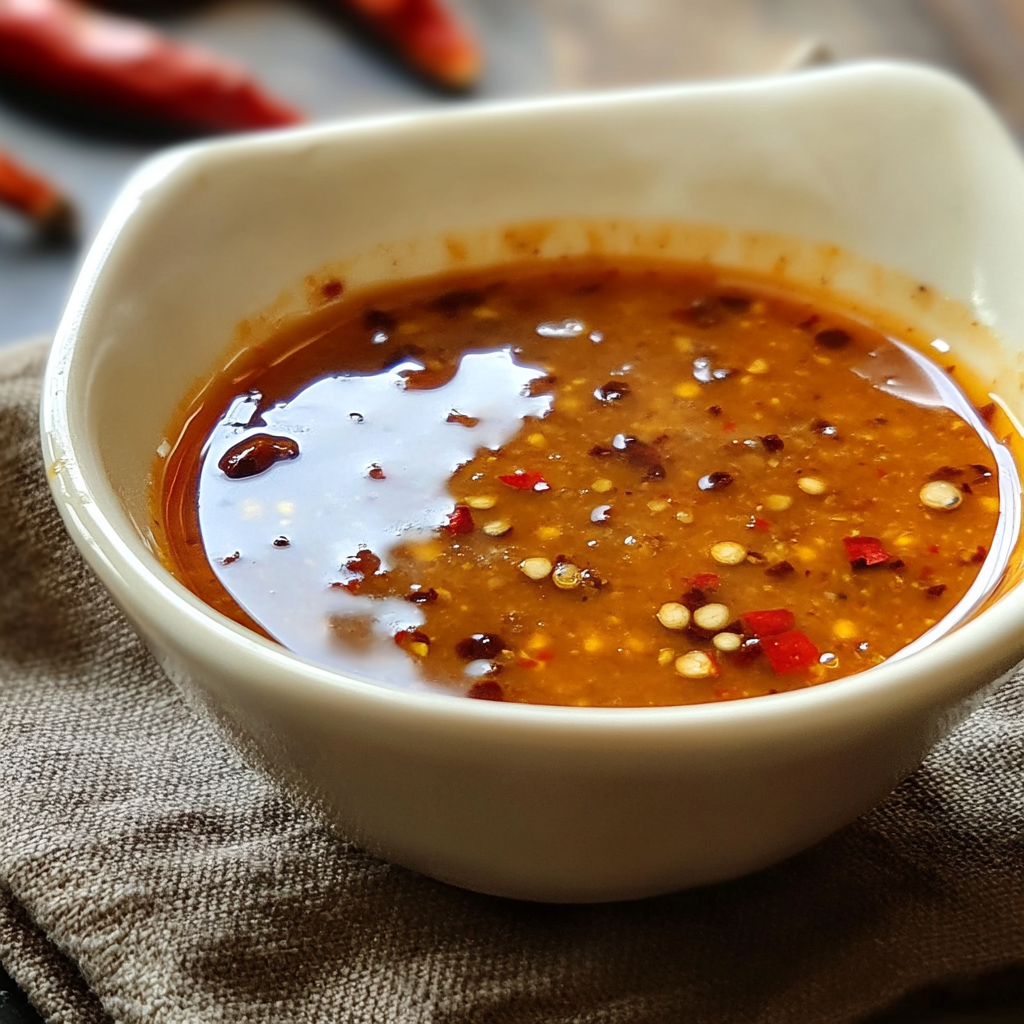
Ever tasted a condiment so bold it challenges your taste buds? Crying Tiger Sauce, the spicy Thai condiment, is taking over American kitchens. It’s not just a side dish; it’s a flavor journey. So, what is tiger sauce, and why do people from Bangkok to Baltimore love it?
This sauce mixes chilies, fish sauce, lime juice, and herbs. It creates a tangy, spicy flavor that makes grilled meats or street snacks pop. But its name suggests more than just heat. It’s tied to Thai traditions and modern American cooking.
Key Takeaways
- Crying Tiger Sauce combines spicy, salty, and sour flavors for a bold, balanced taste.
- It originated in Thailand but has found a creative home in U.S. fusion dishes like pit beef.
- Home chefs can adjust its heat level and ingredients to suit their preferences.
- Its name reflects both its intense flavor and cultural background.
- Learning how to make it unlocks new ways to elevate everyday meals.

What Is Crying Tiger Sauce?
Crying tiger sauce is a spicy condiment that mixes heat, tang, and umami. If you’re curious about what is tiger sauce, it’s a fiery mix at the heart of Thai cooking. Known for its intense heat, this crying tiger sauce is more than just a condiment—it’s a story of tradition.
Origin of the Unusual Name
The name crying tiger sauce comes from its intense spice. The legend says the sauce’s heat could make a tiger cry, earning its dramatic name. It started in rural Thailand but became famous through street food and home kitchens, symbolizing bold flavors.
Traditional Role in Thai Cuisine
In Thai culture, this sauce is more than a side—it enhances flavors. It’s traditionally served with grilled meats, sticky rice, or fresh veggies. Its role is to add depth, balancing sweet, salty, and sour flavors in dishes like ping gai (Thai grilled chicken).
Regional Variations Across Thailand
Thai regions adapt what is tiger sauce to local tastes:
- Northern Thailand: Uses mild chilies and fresh herbs like Thai basil.
- Isaan (Northeast): Heavier on fermented fish sauce and lime for a pungent kick.
- Central Thailand: Balances palm sugar and bird’s eye chilies for a sweeter heat.
These variations show how crying tiger sauce evolves, yet stays true to its fiery roots. Whether you’re in Bangkok or Chiang Mai, its essence remains: bold, authentic, and unforgettable.
The History Behind This Fiery Thai Condiment
What is tiger sauce’s story? Crying tiger sauce comes from Thailand’s Isaan region. It began as a simple mix for grilled meats. Farmers used chili, lime, and herbs to add flavor to their meals.
Over time, it grew into the complex sauce we know today. This sauce has a rich history.
- 1700s: Rural communities used raw ingredients to preserve and flavor food
- 1900s: Became a staple at Isaan markets and festivals
- 1980s: Thai immigrants brought it to American cities like Baltimore, sparking its global fame
Its journey shows Thailand’s culinary strength. What started as a street food is now a symbol of pride. Chefs still use traditional methods, but you can find new versions everywhere.
The name “crying tiger sauce” shows its fiery nature. This trait has been passed down through generations.
Knowing its history makes you appreciate its ingredients. Fish sauce and galangal are key. Every spoonful is a piece of history, showing it’s more than a recipe—it’s a legacy.
Essential Ingredients for Authentic Crying Tiger Sauce
Creating the perfect tiger sauce recipe requires the right ingredients. Each part is crucial for the sauce’s unique heat, saltiness, and tanginess. Here’s how to find and use the key ingredients:
Core Ingredients You Can’t Skip
- Thai chili peppers: Fresh or dried, these small chilies deliver the sauce’s signature heat.
- Fish sauce: Choose premium brands like Tiparos for umami depth.
- Lime juice: Use fresh, not bottled, for bright acidity.
- Toasted rice powder: Grind roasted jasmine rice for texture, or substitute with store-bought kapi jii.
Optional Add-ins for Personalization
Make your sauce your own with:
- Garlic or shallots for depth
- Shrimp paste (kapi) for an umami boost
- Sugar palm syrup (optional sweetness)
Ingredient Substitutions for American Kitchens
Need a substitute? Try these:
- Red chili flakes for fresh Thai chilies
- Rice flour as a last-minute rice powder substitute
- Regular soy sauce diluted with water for fish sauce (use sparingly)
Where to Source Specialized Thai Ingredients
Find authentic items at:
- Major Asian markets like 9th Street Market in NYC or H Mart nationwide
- Online retailers like ThaiGoods.com
- Major chains like Walmart or Amazon for fish sauce and lime juice
Step-by-Step Crying Tiger Sauce Recipe
Ready to make your own tiger sauce? This guide will help you create the iconic condiment. It’s a mix of tradition and technique for a sauce that’s both authentic and versatile.
Preparation Time and Yield
Get ready for a 15–20 minute prep time. You’ll get about 1½ cups of sauce. Store leftovers in an airtight container for up to 2 weeks in the fridge. This is great for future meals or gifts. Adjust the amount based on your immediate needs.
Grinding and Mixing Techniques
Texture is crucial. Here’s how to achieve it:
- Begin by grinding dried chilies and shallots in a mortar and pestle for a rustic texture. Or, pulse briefly in a food processor for a smoother base.
- Add fresh ingredients like lemongrass and galangal last to preserve their bright flavors. Mix well until all ingredients blend but still have a slight chunkiness.
- Tip: Test consistency by dipping a spoon. It should coat smoothly but still show visible herbs and spices.
Achieving the Perfect Balance of Flavors
Success depends on balancing four key flavors: sour, spicy, salty, and umami. Taste often as you mix:
- Sour: Fish sauce and lime juice add tanginess. Add lime slowly to avoid overpowering other flavors.
- Spicy: Adjust chili quantity to your liking. Save a few chilies to mix in later for adjustable heat.
- Salty: Fish sauce is the base. Taste and add soy sauce or salt only if needed.
- Umami: Fermented shrimp paste (prik brine) adds depth. Use it sparingly to avoid a fishy taste.
Pro tip: Stir in palm sugar last to mellow sharpness. Adjust each element a little at a time. This crying tiger sauce should be balanced, not overpowering!
How to Adjust the Heat Level to Your Preference
Learning to control the heat in your crying tiger sauce makes it enjoyable. Start by picking chilies that fit your taste. Bird’s eye chilies are very hot, while Thai red chilies are milder.
For less heat, take out the chili seeds and white parts. They hold most of the heat. Adding more lime juice or fish sauce can also help. Fresh cilantro or cucumber slices can cool down the sauce.
- Mild: Use 3–5 small red chilies, seeds removed.
- Medium: Add 6–8 chilies, leave seeds intact but reduce by half if needed.
- Hot: Include 10+ whole chilies, seeds in, for authentic fiery heat.
“Taste as you grind. Heat builds when chilies are crushed, so adjust slowly,” says Bangkok-based chef Ploen Suthipong, a pro at balancing Thai condiments.

Start with the basic recipe tiger sauce, then adjust the chilies last. Make small batches to test the heat. If it’s too hot, add coconut milk or palm sugar. Always start with a mild flavor and add more heat if you like.
Serving Suggestions for Your Homemade Tiger Sauce
Unlock the full flavor of your recipe tiger sauce with these creative ideas. It’s great with traditional Thai dishes and bold American flavors. This sauce makes street food and comfort classics even better.
Traditional Thai Pairings
Serve your sauce with:
- Grilled or marinated meats like beef, chicken, or pork
- Som tam (spicy papaya salad) for a tangy contrast
- Sticky rice to balance bold flavors
American Fusion Applications
Try it with:
- Burgers: Drizzle over charbroiled patties for smoky depth
- Tacos: Mix into salsa or serve as a dipping sauce
- Roasted veggies: Enhance cauliflower, broccoli, or carrots
Perfect with Pit Beef: The Baltimore Connection
“Our customers love how pit beef tiger sauce cuts through the rich fat of our slow-smoked beef.” — Baltimore Pit Stop, Maryland
| Traditional Pairings | American Pairings |
|---|---|
| Grilled meats | Pit beef sandwiches |
| Som tam salad | Burgers |
| Spring rolls | Roasted vegetables |
Use small amounts (1-2 tsp per serving) to highlight the flavors. Drizzle or dip, but don’t overwhelm the dish. Adjust to your taste!
Storing Your Sauce for Maximum Flavor Retention
Keeping your homemade crying tiger sauce fresh is key. Always move it to a clean glass jar or airtight container. This prevents flavors from getting absorbed by plastic. Keep it in the fridge at 34°F to 40°F (1°C–4°C) for the best taste.
Don’t keep it longer than two weeks. After that, the chili and lime flavors start to fade.
- Glass jars: Ideal for short-term use (1–2 weeks).)
- Freezing: Portion into ice cube trays for up to 3 months. Thaw cubes in the fridge before use.
- Revive old batches: Stir in a squeeze of fresh lime or a pinch of minced cilantro to restore vibrancy.
When using pit beef tiger sauce, keep leftovers separate. This stops the beef’s moisture from weakening the sauce. If it’s cloudy, smells off, or lacks heat, it’s time for a fresh batch.
“The first 48 hours are when the sauce’s chili kick is most intense. After a week, its tang softens, but it still pairs perfectly with rich dishes like pit beef.” — Chef Lek, Bangkok Spice Collective
Freezing the sauce keeps it longer but dulls the aroma. Let it thaw fully before mixing with fresh ingredients. Always sterilize containers that held raw chilies before reusing them.
Common Mistakes When Making Crying Tiger Sauce
Making the perfect recipe tiger sauce requires avoiding common mistakes. These tips will help your what is tiger sauce stay true to its fiery taste.
Balancing the Sour, Spicy, and Savory Elements
It’s important not to let one flavor dominate. Issues to watch out for include:
- Too much lime: Too much acidity can overpower the heat. Adjust the lime as you mix.
- Overdoing fish sauce: Too much salt can hide other flavors. Start with 2 tablespoons and add more slowly.
- Ignoring sweetness: A little palm sugar or honey can balance out the sharpness without being too sweet.
Texture Issues to Avoid
Texture problems often come from grinding or mixing wrong. Here’s how to fix them:
- Watery consistency: Reduce the liquid in the grinder. Use a mortar and pestle for a chunkier texture.
- Grainy paste: Over-processing can make the sauce bitter. Pulse briefly in a food processor.
- Separation: Mix ingredients in batches to ensure even distribution of oil and spices.
When to Add Fresh Herbs
“Add herbs at the end—heat destroys their fragrance,” says Bangkok chef Sompong Lertwilai.
Timing is key:
- Too early: Basil and chilies lose their aroma if cooked. Stir them in after grinding.
- Over-mincing: Chop herbs coarsely for texture. Use scissors to quickly chop and fold in last.
By adjusting these steps, you can turn a good sauce into a masterful recipe tiger sauce. Mastering these details ensures your sauce meets professional standards.
Tiger Sauce Variations Worth Trying
Exploring different tiger sauce versions shows how it changes across regions and trends. You can find everything from milder herbs to bold heat. Let’s look at three standout variations.
Northern Thai Style
This version is milder, with less chili and more herbs like Thai basil and mint. What is tiger sauce here? It’s a mix of sweet lime juice and coriander roots. Add roasted tamarind paste for extra depth.
- Key tweak: 50% fewer chilies than classic recipes
- Add 1 tbsp fresh basil leaves
- Serve with grilled pork neck
Isaan Region Special
The Isaan version is all about intense heat, thanks to toasted rice powder. It’s a traditional recipe but with 30% more chili. The roasted rice adds a smoky flavor.
“The real test is whether it makes you sweat—then you know it’s authentic.” – Chef Somboon, Chiang Mai
Modern Restaurant Adaptations
Chefs today mix global flavors into tiger sauce. Bangkok’s Siam Center Market adds smoked paprika, while New York’s Bangkok Street Food uses pineapple juice. American restaurants pair it with BBQ ribs or fried chicken.
| Variation | Heat Level | Signature Ingredient | Pairing Tip |
|---|---|---|---|
| Northern Thai | Mild | Coriander roots | With herb-stuffed fish |
| Isaan | Extreme | Roasted rice powder | Over sticky rice |
| Modern Fusion | Customizable | Edamame purée | On sushi rolls |
Health Benefits of the Ingredients in Tiger Sauce
Enjoying crying tiger sauce is more than just tasting bold flavors. It’s also a way to add nutrients to your meal. Ingredients like chili peppers, lime juice, and fresh herbs bring health benefits. These align with both Thai cooking traditions and today’s wellness goals.
- Chili peppers: The heat in crying tiger sauce comes from chili peppers. They contain capsaicin, which may boost metabolism and support heart health. It does this by reducing LDL cholesterol.
- Lime juice: Lime is full of vitamin C, boosting immunity and helping iron absorption. Its acidity also aids in breaking down food during digestion.
- Herbs like lemongrass and galangal: These herbs have anti-inflammatory properties. In Thai medicine, they’re used to soothe digestive issues and improve circulation.
Fish sauce adds umami but has sodium. Choose low-sodium versions or dilute it to manage salt intake. Using pit beef tiger sauce with grilled meats like Baltimore-style pit beef adds protein. This doesn’t mean you lose flavor.
Thai cuisine values these ingredients for their health benefits. For a balanced dish, pair bold flavors with fresh veggies or rice. This makes for a meal rich in nutrients. Whether on pit beef or as a dipping sauce, crying tiger sauce is a tasty way to add immune-boosting and anti-inflammatory ingredients to your diet.
Conclusion
Crying Tiger Sauce is more than a condiment. It connects Thai tradition with modern American flavors. Its mix of chilies, herbs, and spices, found in Thai street food, pairs well with dishes like Baltimore’s pit beef. This creates a bold and tasty combination.
Learning about tiger sauce shows its sweet, sour, and spicy balance. This balance appeals to many tastes. It’s a sauce that can be made to fit your personal preferences.
Whether you make it from scratch or use store-bought, you can adjust the flavors. Try different versions or add your own twist. The goal is to find the right balance without overwhelming any flavor.
Once you get the hang of it, share your version online or at parties. Home cooks across the U.S. are mixing Thai flavors with their own. Tiger sauce, whether on traditional dishes or with local favorites like pit beef, encourages creativity while respecting its roots.
FAQ
What is Tiger Sauce?
Tiger Sauce is a spicy, tangy condiment from Thai cuisine. It’s made with chili peppers, lime juice, fish sauce, and toasted rice powder. It’s great for grilled meats, especially in dishes like crying tiger sauce.
How do I make crying tiger sauce?
To make crying tiger sauce, you need Thai chili peppers, fish sauce, lime juice, and toasted rice powder. Mix these ingredients, adjusting the amounts to taste. Our full recipe has detailed steps and tips.
What are the best dishes to pair with tiger sauce?
Tiger sauce is perfect with grilled meats, like beef, and sticky rice. It’s also good in burgers, tacos, and roasted vegetables for a spicy kick.
Can I adjust the heat level of my tiger sauce?
Yes! Change the heat by picking different chili types and adjusting their amount. Remove seeds and membranes for less spice. Start mild and add more to your liking.
Where can I find the ingredients for crying tiger sauce?
You can find ingredients at Asian markets or online. Common stores may have lime juice and fish sauce. For the best taste, choose Thai brands.
What are common mistakes to avoid when making crying tiger sauce?
Avoid flavor imbalances, like too much sourness or salt. Texture issues can come from bad grinding. Add fresh herbs carefully to preserve their flavor.
How should I store my homemade tiger sauce?
Keep your tiger sauce in an airtight glass container in the fridge. It lasts a few weeks. For longer storage, freeze it, but the flavor may change.
Are there variations of tiger sauce I can try?
Yes! Northern Thai versions use fewer chilis and more herbs. Isaan’s version is spicy with a toasted rice flavor. Try modern Thai restaurant versions too.
What health benefits do the ingredients in tiger sauce offer?
Chili peppers and lime juice boost metabolism and aid digestion. Fish sauce is salty, but you can use low-sodium options for a healthier version.




